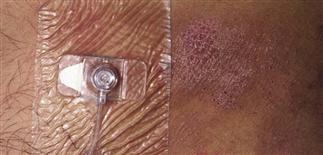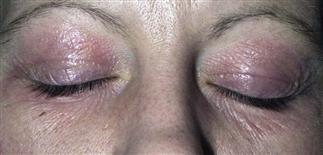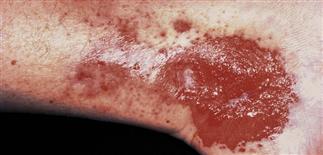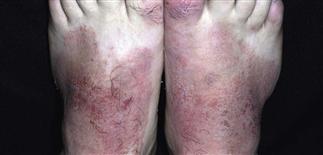Allergic contact dermatitis

Irritant dermatitis is common from tape. This pruritic patch is dry and mildly erythematous. A bland emollient and alternating the taped area will help resolve it.

Eyelid dermatitis can be allergic, irritant, atopic, or sometimes combinations of these. Patch testing to a screening allergen series will help in the assessment of allergic contact dermatitis.

Erythematous patch, with oozing and vesicles. This is spreading contact allergy to bacitracin which was applied to a minor wound.

Bilateral, symmetric erythematous patches. Symptoms are pruritus, periodic flares, swelling, vesiculation. Shoe or medicament allergy, or additives from products used, are possible contact allergens.
DESCRIPTION
A delayed-type hypersensitivity. A form of eczematous dermatitis. Sensitization required; specific to a particular allergen. • Prototypes. Poison ivy, oak, and sumac. • Common allergies. Metals (nickel, chromate, cobalt); rubber additives in gloves and shoes; preservatives or additives in skin products such as creams, lotions, sunscreens, cosmetics, and toiletries; fragrances; dyes; formaldehyde and related chemicals; topical medicaments. Occupational exposures to allergens can be significant.
HISTORY
• Initial exposure, primary sensitization results in eczematous rash 14–21 days post exposure. If previously sensitized, rash 8–72, h later, but variable. May last 3 weeks. Can occur even after prolonged exposure. • Some patients develop multiple contact allergies. • Can develop after years of exposure to products and medications; new exposures also can cause. • Hairdressers, dental care providers, healthcare workers, florists, and machinists at high risk. • Other dermatoses (atopic dermatitis, stasis dermatitis) may be aggravated by contact allergy.
PHYSICAL FINDINGS
• If acute, vesicles or bullae, edema, redness, and often extreme pruritus. May be chronic, erythematous, pruritic eczematous dermatitis. • Distributed at sites of contact, at least initially. If exposure chronic, dermatitis may spread beyond area of contact. • Plant dermatitis typically in linear streaks. • Hands, forearms, and face are most common sites. • Most occupational allergic contact dermatitis affects the hands. • Common facial involvement: pruritic patchy erythema, asymmetric. Airborne matter (e.g. burning poison ivy) results in rash on exposed skin. Photoallergic contact distribution: face, neck, forearms, dorsal hands; spares submental, upper eyelid, postauricular. • Patch testing indicated if persistent or recurrent eczematous dermatitis despite appropriate topical therapy. Patch testing should be performed to a broad panel of allergens including any relevant occupational allergens, tested at proper concentration. Photopatch test patients with photodistributed dermatitis.
TREATMENT
• Identification, avoidance of allergens is essential. • If allergy suspected, start treatment, further evaluate with patch testing. • Begin by simplifying skin regimen and using topical corticosteroid of appropriate strength for site (see topical therapy for eczematous dermatitis). Treat with topical steroid for 2–3 weeks. Discontinue all moisturizers, lotions, and topicals, except plain petrolatum. • Ointments rather than creams preferred. No other topical products (except plain petrolatum or prescribed corticosteroid) should be used during treatment. • For severe or generalized dermatitis, a 3-week tapering course of oral corticosteroids is appropriate. Avoid repeated use. • Some allergens (i.e. hair dye and glues) penetrate gloves; protection may not be adequate. • Some allergens are associated with chronic dermatitis despite avoidance. • Once an allergen is determined by diagnostic patch testing, reviewing allergen exposures, educating about avoidance, and providing suitable alternatives are vital to good outcome.







